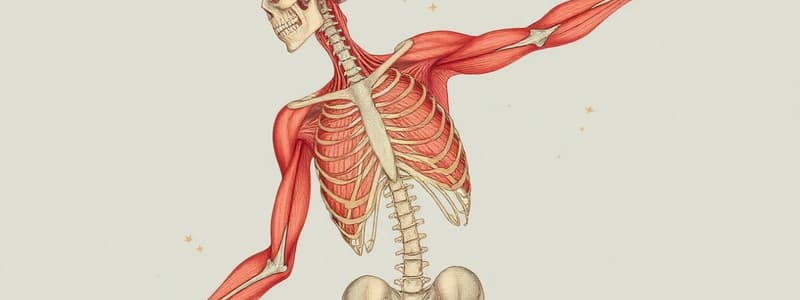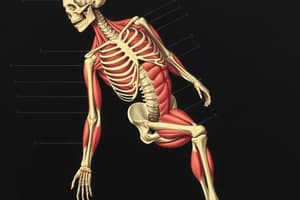Podcast
Questions and Answers
What is the primary function of prime movers in muscle interactions?
What is the primary function of prime movers in muscle interactions?
- They immobilize bones during movement.
- They oppose or reverse a particular movement.
- They reduce unnecessary movements.
- They provide the major force for producing a specific movement. (correct)
Which arrangement of fascicles is characterized by short fibers attaching obliquely to a central tendon?
Which arrangement of fascicles is characterized by short fibers attaching obliquely to a central tendon?
- Parallel
- Convergent
- Pennate (correct)
- Fusiform
How do muscles typically behave during movement?
How do muscles typically behave during movement?
- Muscles can push and pull against each other.
- Muscles pull and create force without any opposition.
- Muscles pull while opposing muscles relax. (correct)
- Muscles only push the insertion away from the origin.
What aspect of muscle naming refers specifically to the number of attachments a muscle has?
What aspect of muscle naming refers specifically to the number of attachments a muscle has?
Which type of muscle is specifically designed to reduce undesirable or unnecessary movements during an action?
Which type of muscle is specifically designed to reduce undesirable or unnecessary movements during an action?
What naming convention would be used for a muscle that primarily extends a joint?
What naming convention would be used for a muscle that primarily extends a joint?
In the context of muscle interaction, what function do antagonists serve?
In the context of muscle interaction, what function do antagonists serve?
What is the main anatomical feature of circular fascicle arrangements?
What is the main anatomical feature of circular fascicle arrangements?
What is the primary role of the effort in a lever system?
What is the primary role of the effort in a lever system?
In a first-class lever, where is the fulcrum located?
In a first-class lever, where is the fulcrum located?
Which class of lever has the load positioned between the fulcrum and the effort?
Which class of lever has the load positioned between the fulcrum and the effort?
What distinguishes the epicranius from other muscles of the scalp?
What distinguishes the epicranius from other muscles of the scalp?
What is the relationship between a muscle's origin and insertion?
What is the relationship between a muscle's origin and insertion?
In a third-class lever system, where is the effort applied?
In a third-class lever system, where is the effort applied?
In a second-class lever system, which component is positioned between the fulcrum and the effort?
In a second-class lever system, which component is positioned between the fulcrum and the effort?
Which class of lever is commonly exemplified by a seesaw?
Which class of lever is commonly exemplified by a seesaw?
What is the role of the effort in the context of lever systems?
What is the role of the effort in the context of lever systems?
Which muscles of the scalp are part of the epicranius?
Which muscles of the scalp are part of the epicranius?
What is the configuration of a third-class lever system?
What is the configuration of a third-class lever system?
Which term best defines the rigidity and motion characteristics of a lever?
Which term best defines the rigidity and motion characteristics of a lever?
What role do fixators play in muscular interactions?
What role do fixators play in muscular interactions?
Which characteristic is used when naming a muscle corresponding to its shape?
Which characteristic is used when naming a muscle corresponding to its shape?
Which of the following describes a fusiform muscle?
Which of the following describes a fusiform muscle?
How do synergists contribute to muscle movement?
How do synergists contribute to muscle movement?
Which arrangement of fascicles is best represented by the pectoralis major muscle?
Which arrangement of fascicles is best represented by the pectoralis major muscle?
When naming muscles, what does the term 'longus' refer to?
When naming muscles, what does the term 'longus' refer to?
Which term best describes muscles that provide the main force for a specific movement?
Which term best describes muscles that provide the main force for a specific movement?
What is the main distinction of pennate muscle arrangements?
What is the main distinction of pennate muscle arrangements?
Flashcards are hidden until you start studying
Study Notes
Interactions of Skeletal Muscles
- Muscles work in pairs, either together or in opposition
- Muscles can only pull, not push
- When muscles contract, the insertion moves toward the origin
- For every muscle action, there is a counteraction
Muscle Classification: Functional Groups
- Prime movers produce the major force for a specific movement
- Antagonists oppose or reverse a movement
- Synergists add force to a movement and reduce unwanted movement
- Fixators stabilize a bone or muscle's origin
Naming Skeletal Muscles
- Location: Muscles are named based on the bone or body region they're associated with.
- Shape: For example, the deltoid muscle is named after its triangular shape.
- Relative Size: Maximus means largest, minimus means smallest, longus means long.
- Direction of Fibers: Rectus indicates straight fibers, transversus and oblique indicate fibers running at angles.
- Number of Origins: Biceps have two origins, triceps have three.
- Location of Attachments: Named based on the point of origin or insertion.
- Action: Muscles are named based on their actions, like flexors and extensors.
Arrangement of Fascicles
- Parallel: Fascicles run parallel to the muscle's long axis (e.g., sartorius)
- Fusiform: Spindle-shaped muscles (e.g., biceps brachii).
- Pennate: Short fascicles attach obliquely to a central tendon (e.g., rectus femoris).
- Convergent: Fascicles converge from a broad origin (e.g., pectoralis major).
- Circular: Fascicles arranged in concentric rings (e.g., orbicularis oris).
Bone-Muscle Relationships: Lever Systems
- A lever is a rigid bar that moves around a fixed point (fulcrum).
- The force applied is the effort.
- The resistance moved is the load.
Lever Systems: Classes
- First Class: The fulcrum is located between the load and the effort.
- Second Class: The load is located between the fulcrum and the effort.
- Third Class: The effort is applied between the fulcrum and the load.
Major Skeletal Muscles: Anterior View
- This view shows 40 superficial muscles divided into 10 regional areas.
Major Skeletal Muscles: Posterior View
- This view shows 27 superficial muscles divided into 7 regional areas.
Muscles: Name, and Action
- Focus on the information provided in the muscle's name.
- Remember that there is always a joint between the origin and insertion.
- Learn a muscle's action by imitating the movement on your own body.
Muscles of the Scalp
- The epicranius (occipitofrontalis) consists of:
- Frontalis
- Occipitalis
- Cra
Interactions of Skeletal Muscles
- Muscles work together or in opposition
- Muscles can only pull, never push
- The insertion of a muscle moves towards its origin as the muscle shortens
- For every muscle action, there is an opposing muscle action
Muscle Classification: Functional Groups
- Prime movers are the main muscles responsible for a specific movement
- Antagonists oppose or reverse a particular movement
- Synergists work together to add force to a movement, reduce undesirable or unnecessary movement
- Fixators immobilize a bone or muscle's origin to help other muscles work more efficiently
Naming Skeletal Muscles
- Muscles are named based on their location, shape, size, fiber direction, number of origins, location of attachments, and action.
- Some examples:
- Location: Pectoralis (chest)
- Shape: Deltoid (triangle)
- Relative Size: Maximus (largest), Minimus (smallest), Longus (long)
- Direction of Fibers: Rectus (fibers run straight), Transverse, Oblique (fibers run at angles)
- Number of Origins: Biceps (two origins), Triceps (three origins)
- Location of Attachments: Named according to point of origin or insertion
- Action: Flexor or extensor, depending on the movement they produce
Arrangement of Fascicles
- Parallel: Fascicles run parallel to the long axis of the muscle (example: sartorius)
- Fusiform: Spindle-shaped muscles (example: biceps brachii)
- Pennate: Short fascicles attach obliquely to a central tendon (example: rectus femoris)
- Convergent: Fascicles converge from a broad origin to a single tendon insertion (example: pectoralis major)
- Circular: Fascicles arranged in concentric rings (example: orbicularis oris)
Bone-Muscle Relationships: Lever Systems
- Lever: A rigid bar that moves on a fixed point called a fulcrum
- Effort: Force applied to a lever
- Load: Resistance moved by the effort
Lever Systems: Classes
- First Class: Fulcrum is between the load and the effort
- Second Class: The Load is between the fulcrum and the effort
- Third Class: The effort is applied between the fulcrum and the load
Major Skeletal Muscles: Anterior View
- The diagram includes 40 superficial muscles on the anterior view of the body
- They are divided into 10 regional areas of the body
Major Skeletal Muscles: Posterior View
- The diagram includes 27 superficial muscles on the posterior view of the body
- They are divided into seven regional areas of the body
Muscles: Name, and Action
- When studying muscles, remember to note the name, description, origin and insertion, and action.
- There is always a joint between the origin and insertion of a muscle
- Action can be learned by acting out the muscle movement on your own body
Muscles of the Scalp
- Epicranius (occipitofrontalis): Consists of:
- Frontalis
- Occipitalis
- Cra
Studying That Suits You
Use AI to generate personalized quizzes and flashcards to suit your learning preferences.




